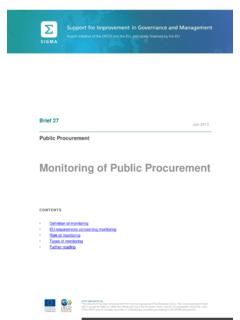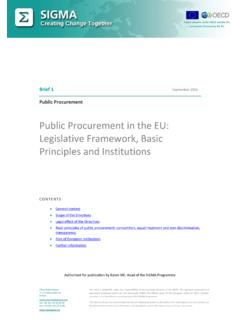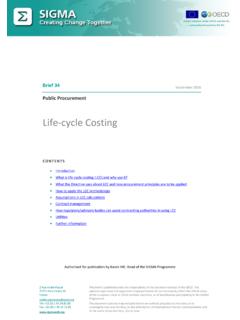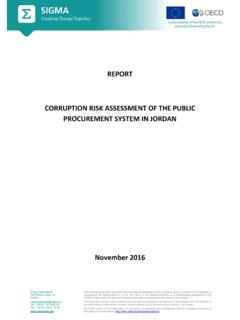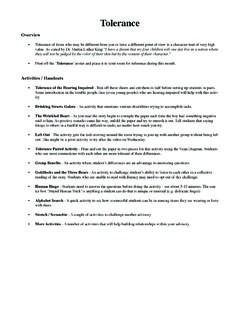Transcription of Contents
1 SELECTED JUDGEMENTS OF THE COURT OF JUSTICE. OF THE EUROPEAN UNION ON PUBLIC PROCUREMENT. (2006-2014). June 2014. Authorised for publication by Karen Hill, Head of the SIGMA Programme 2 Rue Andr Pascal This document has been produced with the financial assistance of the European Union. It should not be 75775 Paris Cedex 16 reported as representing the official views of the EU, the OECD or its member countries, or of beneficiaries France participating in the SIGMA Programme. The opinions expressed and arguments employed are those of the author(s). Tel: +33 (0) 1 45 24 82 00 This document and any map included herein are without prejudice to the status of or sovereignty over any Fax: +33 (0) 1 45 24 13 05 territory, to the delimitation of international frontiers and boundaries and to the name of any territory, city or area. Contents Analysis of the judgements of the Court of Justice of the European Union .. 4. Introductory note.
2 5. Chapter 1 Introduction .. 7. 1. Role and composition of the Court of Justice of the European 7. 2. Types of actions before the Court of Justice and the General Court .. 8. 3. Actions related to public procurement .. 9. 4. CJ proceedings commencement of proceedings to judgment .. 13. 5. Content and publication of CJ judgments .. 15. Chapter 2 Material scope .. 18. Scope and coverage of EU directives on public procurement .. 18. Case law .. 21. C-274/09 Privater Rettungsdienst und Krankentransport Stadler .. 30. C-451/08 Helmut M ller .. 33. Chapter 3 Scope Meaning of a body governed by public law .. 37. Context .. 37. Case law .. 40. C-300/07 Hans and Christophorus Oymanns .. 44. C-393/06 Ing. 48. Chapter 4 In-house procurement .. 52. Context .. 52. Case law .. 55. C-295/05 Asemfo .. 63. C-324/07 Coditel Brabant .. 66. C-196/08 Acoset .. 69. C-159/11 Ordine degli Ingegneri della Provincia di Lecce and Others .. 72.
3 Chapter 5 Selecting economic operators Grounds for exclusion .. 75. Context .. 75. Case law .. 78. C-465/11 Forposta and ABC Direct Contact .. 87. Chapter 6 Selecting economic operators 90. Context .. 90. Case law .. 93. 2. C-218/11 duk v zig and Hochtief Construction .. 98. Chapter 7 Contract award .. 102. Context .. 102. Case law .. 104. C-368/10 Commission v Netherlands .. 109. C-599/10 SAG ELV Slovensko and Others .. 114. Chapter 8 Technical specifications .. 118. Context .. 118. Case law .. 121. C-6/05 Medipac-Kazantzidis .. 124. C-561/12 Nordecon and Ramboll Eesti .. 129. Chapter 9 Changes to contracts .. 132. Context .. 132. Case law .. 134. C-454/06 pressetext Nachrichtenagentur .. 137. Chapter 10 Remedies .. 143. Context .. 143. Case law .. 145. Texts of the judgements of the Court of Justice of the European 155. C-274/09 Privater Rettungsdienst und Krankentransport Stadler .. 156. C-451/08 Helmut M ller.
4 169. C-300/07 Hans and Christophorus Oymanns .. 182. C-393/06 Ing. 197. C-295/05 209. C-324/07 Coditel Brabant .. 223. C-196/08 Acoset .. 234. C-159/11 Ordine degli Ingegneri della Provincia di Lecce and Others .. 247. C-465/11 Forposta and ABC Direct Contact .. 257. C-218/11 duk v zig and Hochtief 268. C-368/10 Commission v Netherlands .. 279. C-599/10 SAG ELV Slovensko and 302. C-6/05 Medipac-Kazantzidis .. 314. C-561/12 Nordecon and Ramboll Eesti .. 327. C-454/06 pressetext Nachrichtenagentur .. 336. The SIGMA Programme .. 350. 3. Analysis of the judgements of the Court of Justice of the European Union 4. Introductory note This SIGMA public procurement publication looks at the key decisions of the Court of Justice of the European Union (CJEU) on nine procurement issues. The publication covers the period from January 2006 to April 2014. Most, but not all, of the relevant CJEU cases on the nine procurement issues are mentioned.
5 Decisions of the General Court (GC) are not discussed. Chapter 1 is an introduction covering: the role and composition of the CJEU, the way in which legal actions are brought and conducted before the CJEU, the content and publication of CJEU judgments, and the consequences of non-compliance with those judgments. Chapters 2 through 10 cover the nine procurement issues: Chapter 2 Material scope Chapter 3 Scope Meaning of a body governed by public law . Chapter 4 In-house procurement Chapter 5 Selecting economic operators Grounds for exclusion Chapter 6 Selecting economic operators Qualification Chapter 7 Contract award Chapter 8 Technical specifications Chapter 9 Changes to contracts Chapter 10 Remedies Each chapter starts by placing the issue in context, with reference to relevant provisions in the directives and, where appropriate, comments on the approach of the CJ based on case law. An overview of case law is provided in each chapter, followed by a more detailed analysis.
6 Where a CJ case is of particular importance, a comprehensive case analysis and a copy of the full CJ. judgment are provided. Terminology The following acronyms are used: CJEU Court of Justice of the European Union CJ Court of Justice GC General Court OJEU Official Journal of the European Union References to Directives: 2004/18/EC Directive 2004/17/EC Utilities Directive 2009/81/EC Defence and Security Directive 89/665/EC Remedies Directive *. 2007/66/EC Amending Remedies Directive *. 5. * Where both remedies directives apply, we refer to "remedies directives". 92/50/EEC Services Directive 93/36/EEC Supplies Directive 93/37/EEC Works Directive 2014/24/EU 2014 Public Sector Directive 2014/25/EU 2014 Utilities Directive 2014/23/EU Concessions Directive 6. Chapter 1 Introduction 1. Role and composition of the Court of Justice of the European Union The European Union (EU) is a unique economic and political partnership between 28 European countries, referred to as EU Member States.
7 The EU is based on two treaties of equal value: Treaty on the European Union (TEU);. Treaty on the Functioning of the European Union (TFEU). The EU is served by a number of institutions, one of which is the Court of Justice of the European Union (CJEU). The CJEU is located in Luxembourg. Its website is Role of the CJEU: The term European Union law (EU law) encompasses the body of law relating to the EU. EU law includes the law of the former European Community (Community law) 1, which has been fully integrated into the EU. EU law takes precedence over the domestic law of EU Member States 2. According to the CJEU, if the effect of EU law varied between Member States, it would jeopardise the attainment of the purposes set by the Treaties. The CJEU is responsible for: securing the enforcement of EU law in cases where it has been breached;. developing and interpreting the provisions of EU law. Structure of the CJEU: The CJEU consists of several sub-courts: Court of Justice (CJ).
8 General Court (GC) 3;. Other specialised courts (currently only one specialised court, the Civil Service Tribunal). The CJEU Registrar provides administrative functions and support. Each sub-court has its own Registrar. Rules of Procedure of the Court of Justice (CJ): The structure and organisation of the CJ and its detailed rules of procedure are set out in the Consolidated version of the Rules of Procedure of the Court of Justice of 25 September 2012 , as amended. 4. Composition of the CJ: The CJ is comprised of judges and advocates general. The Treaty on the Functioning of the European Union (TFEU) requires both judges and advocates general to be chosen from persons whose independence is beyond doubt and who possess the qualifications required for appointment to the highest judicial offices in their respective countries or who are jurisconsults of recognised competence (Article 253 TFEU). All CJ judges and advocates general are appointed by common accord of the governments of the Member States.
9 CJ judges and advocates general have equal standing. 1. Community law refers to the former European Community, established as the European Economic Community in 1957. 2. For example, see judgments of the CJEU in cases 26/62 Van Gend en Loos v Administratie der Belastingen and 6/64 Costa v 3. The Court of First Instance (CFI) was established in 1989 to assist in dealing with an increasing number of cases. In 2009 the CFI was renamed the General Court (GC). 4. Rules of Procedure of the Court of Justice of 25 September 2012 (OJ L 265, ), as amended on 18 June 2013 (OJ L 173, ). 7. CJ judges: Each Member State has one judge on the Court of Justice. CJ judges are appointed for a six-year term and their term of office may be renewed. The CJ judges elect one of their number as President of the Court of Justice, for a renewable term of three years. Advocates general: Nine advocates general assist the CJ judges in their tasks.
10 Advocates general are responsible for presenting legal opinions on the cases assigned to them. Since 2003 they have been required to give an opinion on a particular case only if the CJ considers that the case raises a new point of law. The opinions of the advocates general are advisory and do not bind the CJ. Their opinions are nonetheless very influential and are followed in the majority of cases. These opinions can also be very useful to practitioners, increasing their understanding of the CJ's judgments. They often contain more facts about the cases and discuss legal arguments in more detail than the judgments. How the CJ sits: The CJ may sit as a full court, in a Grand Chamber composed of 13 judges, or in chambers composed of either three or five judges. The CJ sits in a Grand Chamber when a Member State or EU institution that is party to the proceedings makes such a request and in particularly complex or important cases.




